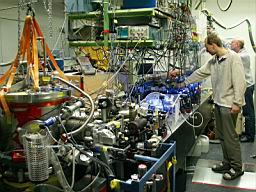3 laser, quantum, optics investigators win Physics Nobel
The hydrogen spectrometer operated by Nikolai Kolachevsky and Mark Fischer. The blue laser light is created by frequency doubling a highly stable dye laser and is subsequently used to drive the 1s-2s transition in a 6K hydrogen beam insiide the vacuum vessel visible on the left side.
Trio wins physics Nobel
for shedding light on optics
Tuesday 4 October 2005
By Niklas Pollard
STOCKHOLM (Reuters) -- Two Americans and a German won the Nobel Physics Prize on Tuesday for optical research giving extremely accurate measurements that could one day be used in deep space travel or three-dimensional holographic television.
The Royal Swedish Academy of Sciences awarded the prize to Roy Glauber, John Hall and Germany's Theodor Haensch for studying light and harnessing lasers to create a "measuring stick" to gauge frequencies with extreme precision.
Such precision will one day be needed for "navigation on long space journeys and for space-based telescope arrays," the Academy said, while Haensch, the youngest of the winners at 63, said it could even lead to "3D holographic television."
Talking from Munich, Haensch told Reuters he was "overwhelmed, happy and speechless" but the party would have to wait: "I have no time to celebrate right at the moment. People are waiting with champagne but I have to go to the airport to go to San Francisco."
Hall, 71 and from Colorado, said he might use his share of the 10 million Swedish crown prize money to endow a scholarship in science and technology.
"I'm very interested in helping young people that don't have financial means," he told Reuters.
CANDLES TO LASERS
"We get most of our knowledge of the world around us through light," said the Academy, calling optics "the physicists' tool for dealing with light phenomena."
The winning trio's research answered such questions as how candle light differs from laser beams in a CD player and how light can measure time more accurately than an atomic clock.
"All three of them deserve the prize," said Peter Rodgers, editor of Physics World magazine. "The general area of quantum optics and lasers is an area in which there has been a lot of progress in recent years. This prize reflects well on progress in that area."
Harvard University's Glauber, 80, said he was woken at home in Massachusetts by a call from an Academy official but he first thought it was a joke. "I could scarcely believe him," he told a news conference at Harvard.
Glauber, who took part in the Manhattan Project in World War Two which developed the atomic bomb, wins half of the prize money, though he expressed surprise that there was a cash award. "Nobody mentioned money."
He laid the groundwork for the Nobel-winning work by establishing the basis for quantum optics in 1963, providing a theoretical description of the behavior of light particles.
STILL A BABY
Decades later, Hall and Haensch, from the University of Colorado and the Ludwig-Maximilians-University respectively, worked on determining the color of the light with extreme precision.
Haensch used even-spaced laser pulses "like the teeth of a comb or the marks on a ruler" to determine the value of frequencies and Hall refined this technique.
Explaining what his and Haensch's teams of researchers had accomplished, Hall said: "Most people have been using a radio dial to scan frequencies to find the right music, we've made it possible to do the same in the optical realm."
"One of the best applications is to test whether what we teach in physics is true or just approximately true," he said.
Hall, retired from an organization funded by the National Institute of Standards and Technology, said he is also working on a project to use related laser technology to identify security hazards in airports. When asked how that would work, he would only say, "Come back in a year."
"It's like a newborn baby," said Hall of laser science. "You know it has fantastic potential but it's much too early to say what it will achieve."
(Additional reporting by Stephen Brown, Peter Starck and Simon Johnson in Stockholm, Philip Blenkinsop in Berlin, Patricia Reaney in London, Jason Szep in Boston and Keith Coffman in Denver)
© Reuters 2005. All Rights Reserved.



0 Comments:
Post a Comment
<< Home